| Aberdare Boys Grammar School | Back to previous page |
Site Home Page | |
This article, written by David Walter Morris in 1996, describes parts of the town centre as they were seventy years earlier in 1926. David was born in 1912 and lived firstly in Broniestyn Terrace and then in Commercial Street. His father was a hosier and outfitter and when the family moved to Commercial Street, the town became very familiar to DWM, which no doubt enabled him to write accurately about the shops and other premises after such a long period of time. Photographs that illustrate some of the paragraphs are used with the permission of Rhondda Cynon Tâf Libraries, and can be found in the online Photographic Archive. |
|||
ABERDARE IN THE NINETEEN TWENTIES.A walk through part of the TownWe shall start our short walk in the 1920s at the Aberdare Public Library and walk down Canon Street and Commercial Street as far as the iron bridge over the River Cynon. On the corner, opposite St. John’s Church, were the premises of Zachariah, the Undertaker. The windows were partly blacked-in and we assume that the workshop, where the coffins were made, was behind these windows. I have a vague recollection of seeing, when I was a boy of 12 or 13, a hay cart, a gambo, coming from Zachariah’s with a very large coffin on it bearing the last remains of a fat man from the circus called Charlie Dunbar — no hearse was big or strong enough to carry that coffin! Behind the Undertaker’s was a very small cobbler’s shop, in a room in the cottage, where Mr. Edwards and his son Horace worked and they were both excellent craftsmen. Above the Undertaker’s was the Aberdare Public Library — at least here was the lending part watched over by Mr. Sturdy and I think his daughter was also one of the staff. I remember a dark passage at the end of which was a flap-counter forbidding further progress. You could not pick a book — you were given one. My impression is that all books were smelly, and they all had a standard binding with green or brown spines and the title in gold tooling – enough to put one off reading books for life! There was a reading room where the daily newspapers, mounted on sloping desks and held down by brass bars, could be read. On the corner of the very small yard was a shop which I think sold ladies’ clothes. Then came a big well-built house, Ty Mawr, where Dr. Harry Banks lived and where both he and his father had a surgery. His father, Dr. Isaac Banks, lived and also had a surgery in Park Lane at the top end of Aberdare Park. Both father and son were fine upright men and I was reminded of them by George VI or Lord Louis Mountbatten. After a short alley-way there were the Aberdare Education Committee Offices where, in my time, Tom Botting was the Chief Education Officer — at that time called, I think, the Director of Education. My earliest memory of the Offices was, when I was only eight or nine, going there and knocking on the first door on the right which bore a nameplate on it with the words ‘Junior Education Clerk’ and, on entering, seeing a white-haired, white-bearded gentleman seated there – my grandfather. During the First World War he had been given a temporary job in the Education Office and they had allowed him to carry on afterwards although he was then eighty. The old Empire Theatre was next door and I think at one time Arkite Phillips led a small orchestra there but we rarely went there. On the corner was the Constitutional Club which, I gathered, was a bit like the local Liberal Club — not noted for its political activities but for the fact that one could get a drink there on Sundays! The Gents’ Outfitter next door was owned by Alec Williams, the proud owner of a powerful motor-bike. He was also a faithful member of Trinity Chapel next door. We knew him as Mad Alec’ as he liked speed. He once took me for a ride on the back of his bike and there wasn’t a pillion on it! I hung on very tightly, sliding a bit from side to side, and, as we approached Hirwaun Road I suddenly remembered I had to meet someone very urgently — it was a long way back to Town! Alec looked after his widowed mother extremely well. She was a sweet soul and always wore a hat which was crowned with artificial pansies. She was very friendly with my mother and, because of her hat, we called her Mrs. Pansy Williams. I remember once, sitting in the Hall at the County School doing an examination, and gazing idly out of the window, seeing a hat with pansies on it, bobbing along at the top of the school hedge — it was Mrs. Williams sitting very upright in Williams’s open Penderyn bus! |
 Undertakers and Library first left
Undertakers and Library first leftSt Johns out of sight on right Tram rails in road  Ty Mawr, looking away from Town.
Ty Mawr, looking away from Town.Banks, Banks & Ogilvie, Physicians and Surgeons  The
Poplars, next to Ty Mawr The
Poplars, next to Ty MawrHome of Evan Griffiths, architect and his daughter Miss Jennie Griffiths, County School mistress, 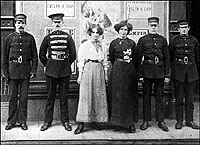 Staff
of the Empire Theatre Staff
of the Empire TheatreThe orchestra leader referred to in the text, was the father of P.E. Phillips 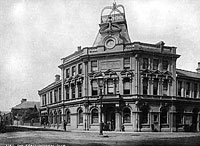 The
Constitutional Club The
Constitutional Club Trinity
Chapel Trinity
Chapel |
Between Alec Williams and Trinity Chapel was, I am almost sure, a sweet shop — did this belong to Mr. Ruck who was a manufacturer of boiled sweets? The Rucks lived in Broniestyn Terrace and the son, Wilfred, was my age and we were quite friendly when very young. In my early days Trinity Chapel was a Calvinistic Methodist Chapel and only during my teenage did it become a Presbyterian Church of Wales but it was always English-speaking. The Rev. Humphrey Evans was the Minister until the late Twenties when he retired and the Rev. D.O. Calvin Thomas took his place. How different were things in those days for at the evening services every seat was taken and the chapel was quite full for the morning service. Of the four cinemas in Aberdare, The Cosy, The Park Cinema, The Aberdare Cinema and the Palladium, I think the Palladium was our favourite one although one can become a bit nostalgic about the Saturday morning children’s matinees at The Cosy in the silent-film days of Mr. Hagger and admission two old pennies. However, back to the Palladium, where, apart from the cinema shows two almost annual events come back to me. The first was the annual visit of a Shakespearean Company when a different play was put on every night of the week. The other event was the Annual Prize Day of the Boys County School when the masters ‘decked themselves out in their finest array’ and, instead of listening to the speaker, we would be trying to work out which University each colourful hood represented. Every year Jimmy Excell, in his Persil-White kit, would put on a PE Display with the more athletic senior boys. A Confession — the only time I ever got caned by the Headmaster was for being helpful and going down to the Palladium on the morning of Prize Day on the lorry taking the PE Apparatus for the Display without permission — a bit unjust but perhaps it made up for other undetected ‘crimes’. The rather good-quality boot and shoe shop next door was owned by Mr. Lewis, a rather short gentleman but always so pleasant and helpful, He was ably supported by his assistant, David Jones, who later became the manager and eventually, I believe, the owner — a worthy successor! I seem to remember that the Scotch Wool Shop had two steps up but I could be quite wrong — in its heyday it was a very busy little shop. I think there were offices above, or next-door and above, but as I had no reason for calling there I have no real recollection. The two Italian Ferrari Brothers had the adjoining restaurant and pastrycooks and what beautiful pastries they made (when you could afford them!). In the early thirties Ferrari’s Cafe was the morning meeting place for those home on holiday from college for the Ferraris did not mind if you made your cup of coffee last an hour or more. There were a draper’s and ironmonger’s shop in close proximity but I cannot remember which came next to the Cafe. The name Theophilus seems to ring a bell but this may refer to a much later date. Hopkins the Ironmongers was one of my favourites with all its screws and nails and wire and tin-plate pots and pans. I remember Mr. Hopkins (was it Jack?) with his black apron and his son Harold. Harold was older than I was but seemed destined to become an ironmonger — I think he always wore a grey warehouseman’s coat. Between two of these shops was a staircase leading up to a billiard saloon (forbidden territory!) and I probably only went there once or twice in my life. On one of the occasions I was there, we heard a terrific bang — a big trailer had come adrift from its lorry and crashed into Thomas the Outfitters opposite, smashing the shopfront. It was exciting news but how could I pass it on when I shouldn’t have been there! A dark wire-mesh covered the window of the next premises — was it a solicitor’s office? Then there was a stationer’s shop — was it Price’s? I think it was there after Burton’s was built but I don’t remember it closing. I can just remember that there was an hotel on the corner before it was pulled down for the erection of the then very modern Burton the Tailors shop. |
 Rev.
Gwilym Humphrey Evans (C.M.) Rev.
Gwilym Humphrey Evans (C.M.) The
Palladium The
PalladiumInitially The Temperance Hall, later New Theatre and Hippodrome 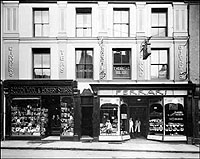 Scotch
Wool Shop (left) Scotch
Wool Shop (left)Ferrari’s (right)  W.T.
Price, Stationer W.T.
Price, Stationer Looking
up Canon St. with Burton’s on the right Looking
up Canon St. with Burton’s on the right |
Crossing the end of Whitcombe Street, facing us is Olivers the
Boot Shop. The Manager was Percy John who was a keen member of Trinity Chapel
and later a deacon there and who was also an active member of Toc H. Lloyds Bank
occupied the imposing adjoining buildings, where, in those days, if you obtained
a job you were made for life. Above the Bank were the offices of Alwyn John,
Solicitor. I think he became the District Coroner later. He was in the sixth
form when I went to the County School and was in the School 1st XV. The last
shop at this end of Canon Street was the millinery and linen shop of Prance Williams
with a tremendous and varied stock in quite small premises. I was always great
friends with the younger son, Leslie, and we were still in correspondence earlier
this year. |
||
 Lloyds Bank
Lloyds Bankwith solicitors C. & W. Kenshole & Prosser in offices above |
 Prance Williams
Prance WilliamsThe tram rails in front of the shop are also shown in the next photograph |

A Trecynon bound tram right) passes an Abercwmboi tram
(left) in front of Prance Williams’ shop, with Liptons in the background. Trams
ran in Aberdare from Oct. 9th, 1913 to April, 1935. The track was single, with passing
loops, from the terminus at the bottom of Cwmdare Hill, but was doubled as it ran
along Canon Street and down to the cinema in Cardiff Street and onto Regent Street
in Aberaman. It then ran on single tracks to both Cwmaman and Abercwmboi. Cwmdare
and Abernant were served by trolley-buses that linked to the tram stopping points.
|
Going back to the top end of Canon Street (i .e. near the old Town Hall) the first shop was an Italian cafe, the name of the owner eludes me at present. The formidable building next door was the Masonic Hall and although my father and many of his friends were Freemasons we always wondered what went on so secretly behind the locked doors! A greengrocery and fruit shop followed and I think a butcher’s after that, Halewood’s double-fronted boot and shoe shop came next and there was a factory behind which became a centre for the unemployed. I remember Mr. Halewood and his very attractive granddaughter, Bobby Hughes. Above Halewood’s were two or three rooms which were used by the B.W.T.A. (British Women’s Temperance Association) and my mother and grandmother both belonged to it. I went there once or twice when I was quite young — one went up stairs on the left-hand side of Halewood’s shop and I remember two things, the very highly polished lino and a gas fire with a bowl of water in front of it which I was told was to keep the air moist. Probably it is more interesting to relate seeing Mother Shepherd there in her small bonnet tied under her chin and she was quite frail. Mother Shepherd brought the Salvation Army to Aberdare in the late 1870s so she must have been quite old at that time. I think an office separated Halewood’s from the old Post Office but I am not sure if I have the next four or five premises in the right order. Richard Hurt’s, the Fishmonger, with its open front and large lumps of ice must have been very cold in winter. The only public house in Canon Street at this time was the Carpenters Arms and this was near here. Next door would have been Thomas the Outfitters. There was a son, Howard, and I seem to remember another son, Bert, but perhaps I am quite wrong. Mr. Thomas must have had something wrong with his throat because his voice was always a bit hoarse. Paul Mascherpa was an unusual tall Italian and was always so pleasant and ran a very good cafe. Any of my generation still about will remember the great pleasure they always had in walking round Longstaffe’s Penny Bazaar — everything was not a penny, but nothing cost much more! A wooden floor, counters down each side and perhaps at the end and these counters divided into sections where one could wander round and spend one’s ‘Saturday’s Penny’. Anyhow, that’s how I remember it! Either next door or next door but one to the Penny Bazaar was R.H. Miles & Son, the Butchers. I do not think I would ever have seen Mr. R.H. Miles but I knew his son, Tom Miles, who was a peer of my father and a fellow deacon at Trinity Chapel. Tom Miles had four children, Betty, John, Nancy and Jennie. Betty, the eldest, worked for a time in the cash desk in the shop, John became a doctor, Nancy went as a nurse to London and I believe she married a South African and went to live in South Africa, and Jennie, the youngest, became a teacher. Betty married Ernie Reynolds, a colliery surveyor, and they lived just over the level crossing at the top of Monk Street. Mr. Miles worked in the shop occasionally but he would have been busy going round the countryside buying cattle. I remember quite well the Manager, Mr. Price, in his white coat and apron, and his brother, in blue overalls, who was probably responsible for the slaughterhouse side of the business. A thought has just struck me! Before the Ferraris came, wasn’t the Cafe owned by the Miles family? |
 Masonic
Hall (right) Masonic
Hall (right) Halewood’s
Boot Factory Halewood’s
Boot Factory(formerly Glandare Woolen Mill) (behind the shop and on the site of the current High St. car park) 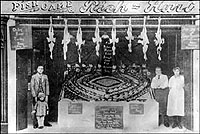 Hurt’s
Fishmongers Hurt’s
Fishmongers The
Carpenters Arms The
Carpenters Arms Paul
Mascherpa, Confectioner Paul
Mascherpa, Confectioner |
There may have been another shop before Lennards, the Boot and Shoe Shop but, if so, I cannot recall it. Then there was a small grocery shop owned by Mr. & Mrs. Williams, a very nice couple. Mr. Williams was very tall and thin with glasses and his wife was quite short. Our favourite newsagent, Bill Cable, was always cheerful and, as young children, we bought our ‘comic’, The Children’s Newspaper, from him. What do I remember of The Maypole next door? It was always spotlessly clean with a black and white tiled floor and some marble counters. Biscuits were kept loose in large tins about ten inches square and you could buy a bag of broken biscuits for a penny or two pence (old pence, of course!). But I am certain that it was at the Maypole that butter came in large cubes, about 12x12x12 inches and the assistants would cut off half a pound and, with a pair of butter pats, would more often than not get the butter the correct weight. Next door was Mr. A.D. Jones the Tobacconist, noted for the great variety of tobaccos and cigarettes he stocked and sold. I am sure that his daughter served in the shop in the Twenties with her father. Later on, his son, Trevor, took over the business. Tucked in the next corner was a small flower shop but I do not know the name of the owner. I am almost sure that there was another fishmonger’s next to this — it couldn’t have been Hurt’s because that was in the middle of Canon Street! Under the shadow of the spire of St. Elvan’s Church nestled one of the most important buildings in the Town Centre — the gentleman’s toilet! From here one crosses the small square at the top of Commercial Street where, we were told, the River Dare ran under this square. The first premises in Commercial Street were those of the Cafe Mona (Who was Mona, What was she?). When I remember it first it was owned by F.W. Caunt and at that time it was The Place for morning coffee or afternoon tea. One or two of the local groups, such as the Aberdare Rotary Club, held their regular lunches there. Later Mr. D. Rees Jones took over and I think of him as a dapper little man who was occasionally seen driving his very elegant trotting horse through the town. The cafe upstairs spread over two premises with Halfords Cycle Shop below the lower part. There was a small stores next door selling groceries but I have a recollection of another fish shop here — was it Burge Bros.? Then came the great store of Woolworth, the 3d and 6d store with its advertised ‘Nothing over sixpence’ and such a variety of goods laid out for the delectation of its customers. Above Woolworths was the ‘Luke’, the Lucania Billiard Saloon, with a large number of billiard tables. The Grocer’s shop next door was the Home and Colonial Stores (or was it the International?). The name Briggs seems to remind me of something here but I cannot think what it is. Another Grocers’ — Fletchers. Was Mr. G.T. Harvey the Manager and afterwards the owner? A prosperous Boots the Cash Chemists came next and the Manager was a dapper short man with the unusual name in Wales of Davies! They had quite a good branch of the Boots Lending Library where you paid an annual subscription and were issued with a ticket which was inserted with a silk cord into a small loop in the spine of the book. A trade secret — Boots always marked their goods with price to customer and with two letters, the latter representing their cost price. They used the phrase ‘Push Trade’ for their code with its letters representing the numbers 1 to 9. An item marked 3/9 for the customer would perhaps have the letters U/D I .e. 2/8 on it. Although there were several grocers’ shops in Commercial Street there were even more public houses but I must say I remember very little drunkenness or rowdy behaviour. The Eagle Inn, next to Boots, was quite old, it was painted a faded blue and looked very dead. Perhaps, as it was closed in the 1920s, I do not remember it when it was open. Then came Lloyd’s the Grocers with Tom Lloyd the owner, a tall gentleman with a rubicund face, very little fair hair and always wearing a white coat. I think he had a wine and spirit licence also. Mr. Lea the Jeweller came between Lloyd’s and the Prince of Wales, a well-conducted inn run by Mrs. Wilson and her daughter, Rona. Between the Prince of Wales and the fruit shop next door there were stairs leading up to Stephens Printing Works above the fruit shop. David Stephens took an active part in the affairs of the town and was a stalwart of the Welsh Congregational Siloa Chapel where two of his fellow deacons were James Williams, the Brecon Meat Supply, and John Zachariah, the Undertaker.  Thomas Lloyd 15–17, Commercial Street 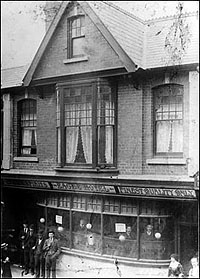 The Eagle Hotel |
 W.
Cable, Tobacconist W.
Cable, Tobacconist The
river Dare exposed in its culvert, The
river Dare exposed in its culvert,May 1972. The camera is at Cafe Mona pointing toward Liptons, which is the name on the shopfront just visible through the paling fence. 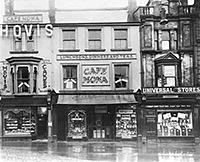 Café Mona, Café Mona,No. 1 Commercial St.  Briggs
Boot Shop, on left Briggs
Boot Shop, on left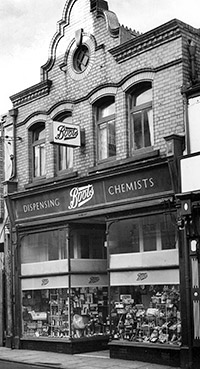 Boots
the Chemist Boots
the Chemist |
Another pub — the George Hotel (a bit of a misnomer – not what I would think of as an hotel!). Almost on the corner site of Commercial Street and Gloucester Street was the draper’s shop of R.P. Jones — did it once stretch to the corner because I remember the end premises being those of the Ideal Cleaners. Upstairs on the corner was the Y.M.C.A. (Young Men’s Christian Association) and George Price was the leader in charge. I cannot remember what happened to the YMCA or to George Price. Although not in Commercial Street just round the corner in Gloucester Street was the Crown Hotel where the Aberdare Rugby Club and their opponents changed before the long walk to play on the Ynys. About 1930, David Evans, son of Emrys Evans the Chemist, was Captain of the Aberdare Team and I played for them a couple of times when they were short. But I must say that playing for them in the forwards was not the most pleasurable of pastimes for they did not shave before a match on principle, they saved their weekly bath until after the match and they would have a couple of beers before the match to give them strength! On the next corner was W.H. Smith the Booksellers etc. and next door a very small sweet shop. Above these premises was the surgery of Trevor Flooks the Dentist — probably the most up-to-date dentist in Aberdare at the time but even his tooth-drilling machine was foot driven. If the Taff Vale Railway line gates were closed then, if in a hurry, one used the little footbridge to cross the line. Here we come to the last building on this side of the road before the then iron bridge over the River Cynon and that was yet another pub — the Commercial Hotel. When is a pub not a pub but an hotel?? Crossing the road to go back up Commercial Street, what did we find? An hotel! The Iron Bridge. Between it and the river bank was an Italian Cafe and sweet shop. Tucked in the corner between the Iron Bridge and the signal box was also a sweet shop. The other side of the railway crossing was the Dukes Arms — the exterior walls were rather like those on the inside of a public lavatory, brown glazed bricks. We have not finished with our pubs yet for opposite, on the bottom corner of Commercial Street, was The Railway Bar. Perhaps we should describe the next shop as The Health Shop because they sold foods like cereals, herbs etc. Mr. Jones the Wallpaper Shop sold everything for home decorating and he had a daughter, Rosemary, who was two or three years younger than I was and a school friend of my sister. At that time a group of us, perhaps seven or eight, would go for quite long walks during the summer holidays. I remember on one occasion we took the Council bus to Hirwaun and walked up the tram road to Penderyn. From there we walked across the moors as far as the Hepste Falls, a favourite walk of ours. On our way back Rosemary Jones, who was one of our party tripped in a hole and broke her ankle although we thought it was a bad sprain. I suppose we must have taken it in turns to carry her back as far as The Lamb Inn where we would have got Mr. Williams’s bus back to Aberdare. The outcome of this was that her ankle was set badly and poor Rosemary was crippled permanently but I remember she always remained cheerful. Again, I cannot remember the name of the Italians who owned the cafe next
door ~ was it Servini ? The adjoining Saddler’s shop always had a lovely
smell of leather. There was a workshop at the back where the saddler, Bill Reynolds,
reigned supreme. He was a great craftsman and would make or repair any leather goods.
He was also very proficient at restringing tennis rackets (racquets). The shop was
owned by Mrs.
Evans the Saddler Between my father’s shop and Evans the Saddlers was Twissell’s the China shop. I remember the father quite well and when he died his son, Jack, took over although I seem to remember that Jack’s wife appeared to do most of the work. I always used to think that ‘a bull in a china shop’ would have enjoyed himself there because the floor was covered with tea and dinner services etc! |
 Thought
to be the interior of George Hotel Thought
to be the interior of George Hotel Looking
up Commercial Street; Looking
up Commercial Street;YMCA first on right 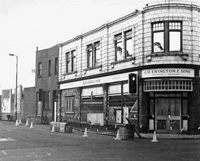 The
W.H. Smith building when The
W.H. Smith building whenit had become Ewingtons  View
from the Iron Bridge View
from the Iron Bridge(over the Cynon). Both out of sight, the signal box was on the left, and the pedestrian footbridge on the right. 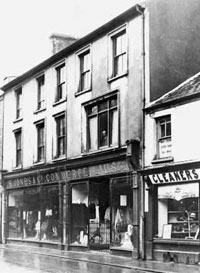 S.
Jones, No. 30 S.
Jones, No. 30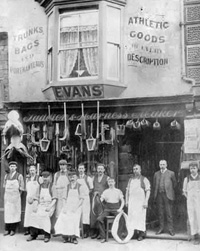 Evan
Evans, Saddlers. Evan
Evans, Saddlers.No. 37 |
My father was always known as Morris the Hatter, known by his colleagues as Bill Morris but by his family as Willie. I was born in Broniestyn Terrace in Trecynon and we lived there until after the 1926 strike when things got so bad we had to move to live over the shop. Shopkeepers were always very caring about their premises in those days, windows and brass were cleaned daily and they all swept the pavements outside their shops. We had two men on the staff — Evan John Williams, who, sadly, had to leave after the strike but, fortunately, got the job as Manager of the Aberdare Market, and little John Lewis from Aberaman who was a tireless worker. I used to help in the shop and we would still be open at 10.30 on Xmas Eve when latecomers would come in for a new cap at 1/11 or 2/6. In my earlier days our neighbours were Mr. & Mrs. Gibbs who owned a yapping Peke. He was a tobacconist and the shop was quite small with its brass scales for weighing, tobacco on the counter. They were a very nice couple but I do not remember when they left or what became of them. There was another grocers next door to the Gibbs’s shop but it was a company shop rather than belonging to an individual. Once more a public house, The Bush Inn, which had been there for almost a hundred years. Mr. Thomas the Jeweller’s very nice shop came next and Sam Watson had his photographic studio above. Almost every studio or wedding picture taken in Aberdare during the twenties and thirties was taken by Watson’s Studios. Before Mr. Watson’s time The Photographer was Mr. Berry. And so we come to our last pub in Commercial Street, No. 10 which was The Globe Inn, another very old inn — so many were built in the 1860s in Aberdare. Why was this? It was not the coming of the railway because that happened early In the 1840s — it must have been that more and more collieries were opening at this time. It would appear that I have an unhealthy interest in the pubs of Commercial Street but it was only a short street and of the fourteen pubs there five were opened in 1861 and three more in 1869. As we near the end of the street there was the Cleaners — was it Johnsons? The best fruit shop In Aberdare was Ted Ruther’s (We always called him Mr. Rutter — but perhaps that is how it was pronounced). He always used to say that whenever a new girl was employed he would tell them to eat as much fruit as they liked and he always found that after a week they never touched any more fruit again. Around the comer from the fruit shop was Liptons the Grocers. I assume that this was just in Commercial Street ~ another clean and busy shop. Above Liptons was the surgery of Mr. Knight the Dentist, another very good dentist. His son was Colin Knight, one time Captain of the School Cricket Eleven. For two years Colin had been the School Scorer and, when he became Captain, I took his place as Scorer. But after two years as Scorer no great honours came to me, not even a place in the team except on one occasion when one of the team failed to turn up! After nearly seventy years my memory of the 1920s has become somewhat dim and perhaps a little confused over names, dates and places — but how many of my peers remain to correct my mistakes. Many, I hope! David Walter Morris |
 Bush
Inn (modern photograph) Bush
Inn (modern photograph)No. 43 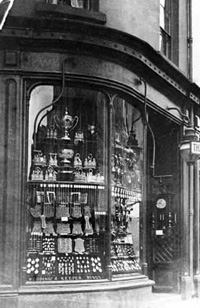 Thomas & Co.,
Jewellers. Thomas & Co.,
Jewellers.No. 44  Liptons
(in 1962) Liptons
(in 1962) |
A Table of Businesses in Canon and Commercial Streets |
|
Canon Street(Numbers run from 1 next to Trinity Chapel down to Lloyds Bank and
then back up the other side to about No. 42) |
Commercial Street(Numbers run from 1 at Cafe Mona down to 24 and then back up the other
side to about No. 50 opposite F.W. Woolworth) |